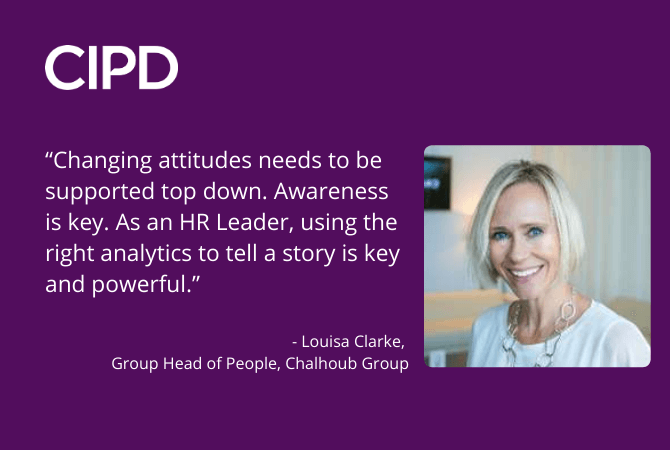As women are more likely to pick up extra caring responsibility during the current outbreak, experts warn that coronavirus will disproportionately affect women in the workplace. So keeping diversity and inclusion on the agenda is more important than ever.
In this interview, we speak to Louisa Clarke, Head of People at Chalhoub about strategies to support women’s inclusion at the workplace.

Tell us a bit about yourself and your path.
As a teenager, I was very active on the sports field and always imaged myself as a Physical Education Teacher or Primary Teacher,. Later, as I started to apply myself and my grades improved, I was encouraged to think more academically and ended up studying law and started in the legal profession.
Although a very different path, the discipline of law and then 12 years in consultancy ingrained in me a discipline and a work ethic which has driven me ever since. I have changed career paths several times, and each time what went before was a stepping stone along the way.
Throughout your career, did you find support from mentors or sponsors?
Every now and then, you find someone in your work environment who 'gets you'. Who sees the best in you and the potential you can bring. I was extremely lucky to have several of these influencers in my work life. Each encouraged me and inspired me to push myself and believe in myself in a way I would not have done without their faith and encouragement. One statement which always stayed with me is “surround yourself with a team who are better than you!” As leaders we don’t know it all, and I would hope my team see this is me now, I love coming across talent who clearly excel in areas I do not, and allow them the opportunity to shine, develop and create the ripple for others.
We often hear about the glass ceiling – the phenomenon where women will progress in their careers up to a certain point, and eventually get ‘stuck’. You’re now quite ahead – but have you ever felt this way? What can you say to women who feel this way?
I genuinely feel proud to be a working mum of two and have never let my gender hold me back, but I can absolutely relate to some of these sentiments. After having two children close together, I returned to a very active consulting role, requiring a significant amount of travel and long hours. Having taken two maternity leaves back to back, I could see I had slipped behind my original 'pack'.
For many women, this is a natural consequence of motherhood. Pausing, or having to plateau for a short period for those who want to progress should be a blip in your career – not a stop sign. For me, it was about finding the right environment and, most importantly, the right employer. Some people want a 'job', others want a 'career'. In the right organisation, where your personal values align with those of the employer, and where the systems, processes and management attitudes put people first, and respect and support the reality of working parents, there should be no ceiling. It’s sometimes hard to make bold decisions, but 'being stuck' at work so often means stuck in that organisation. Opening new doors, can open limitless opportunities elsewhere.
As a people professional, what do you believe makes a real difference to promote greater female representation at the workplace?
For me, it’s about calling out 'bad behavior'. As humans, we naturally have conscious and unconscious bias, but when you have the support at the top of the organisation to stamp out bias, the culture will change. I am also a huge advocate of the benefits of flexible working. The reality of life is that we all have competing demands on our time and on our energy. I personally excel when I have the flexibility and trust to operate in a way which allows me to balance the priorities in my life, and is a trend we are seeing and hearing about more and more in the region, which is great.
Why is increasing women’s participation at work important for businesses?
Over the years, I have sat on several leadership teams as the only female in the room, or have observed sometimes heated management meetings in male-only teams. Whilst there is no gender bias to the capability of role holders, gender representation does bring a different dynamic to a team. Gender equality is not a female issue, it’s a challenge across society which affects the perception of women.
There is no one-size-fits-all solution – but is there one approach that you have seen make a real impact on women’s inclusion at work?
I am a big believer in coaching. In one of my previous roles, we accelerated the development of high potential females through executive coaching. Allowing them to reflect on what was holding them back, as well as pairing them with an internal career mentors really helped them build their strong personal brands, and be considered as equal contenders when it came to succession planning.
As a woman in a leadership position, what do you think is your role in enabling more women to go up the ranks?
Changing attitudes needs to be supported top down. Awareness is key. As an HR Leader, using the right analytics to tell a story is key and powerful. My role is also to build the skill set of Line Managers. Ensure that they have the training and right mindset to coach, to mentor, to ask the right questions and really understand both the career aspirations and the blockers of their team members.
What would be one piece of advice for women who want to ask for that raise, a promotion or more inclusive policies?
Go with accurate internal/external benchmarks and comparisons, don’t just make assumptions. Before approaching management, consider whether your HRBP or HR can support your argument and act as your advocate.






